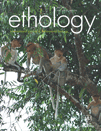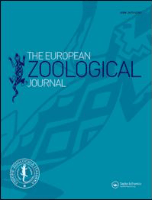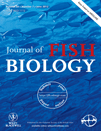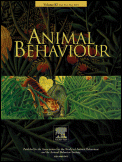
BEHAVIORAL ECOLOGY AND SOCIOBIOLOGY
Scope & Guideline
Illuminating the Evolutionary Threads of Behavior and Ecology
Introduction
Aims and Scopes
- Behavioral Ecology:
Research in this area examines how animal behavior is affected by ecological factors, including resource availability, predation risk, and environmental conditions. - Sociobiology:
This involves studying social structures and interactions within and between species, focusing on cooperative behaviors, competition, and social hierarchies. - Evolutionary Biology:
The journal publishes studies that explore the evolutionary implications of behavioral traits, including sexual selection, parental investment, and life history strategies. - Cognition and Learning:
Research examining cognitive processes and learning behaviors in animals is a key focus, including how these processes influence foraging strategies and social interactions. - Conservation Behavior:
The journal also addresses the behavioral aspects of conservation, exploring how behavioral ecology can inform conservation strategies and the impacts of human activities on animal behavior.
Trending and Emerging
- Impact of Anthropogenic Change:
Research focusing on how human activities, such as urbanization and climate change, affect animal behavior and social structures is gaining prominence, reflecting the urgent need to understand these impacts. - Social Networks and Dynamics:
There is a growing interest in studying social networks and the dynamics of social interactions among individuals, which provides insights into cooperation, competition, and communication. - Integrative Approaches to Behavior:
Studies that combine behavioral, ecological, and genetic approaches to understand complex behaviors and their evolutionary implications are increasingly common. - Cognitive Ecology:
Emerging research on the cognitive abilities of animals and how these influence their behaviors in natural settings is trending, with implications for understanding learning and problem-solving. - Microbiome and Behavior:
The exploration of how gut microbiota influences behavior and social interactions is an emerging theme, linking ecological and physiological aspects of animal behavior.
Declining or Waning
- Traditional Ethology:
Research rooted in classical ethological studies appears to be less prominent, as more emphasis is placed on integrating ecological and social dynamics into behavioral studies. - Static Behavioral Observations:
Studies that focus solely on static behavioral observations without considering environmental or social contexts are becoming less common in favor of more dynamic, integrative approaches. - Single Species Studies:
There is a noticeable shift away from research focusing exclusively on single species in isolation, with a trend toward multi-species interactions and ecological networks. - Laboratory-Based Experiments:
While controlled experiments remain important, there is a waning interest in lab-based studies that do not translate well to natural settings, leading researchers to prioritize field studies.
Similar Journals

ETHOLOGY
Innovating Understanding of Animal InteractionsETHOLOGY, published by WILEY, is a prestigious journal that has been at the forefront of animal behavior research since its inception in 1986. With an ISSN of 0179-1613 and E-ISSN 1439-0310, this journal holds a significant position, categorized in the Q1 quartile for Animal Science and Zoology and Q2 for Ecology, Evolution, Behavior, and Systematics as of 2023. Recognized for its rigorous peer-review process and comprehensive scope, ETHOLOGY publishes cutting-edge research that illuminates the complexities of animal behavior, making it an invaluable resource for researchers, professionals, and students alike. With an impact factor that underlines its relevance in the field, the journal's commitment to advancing knowledge in ethology is evident through its extensive citation and ranking metrics, including a commendable position in Scopus for both Animal Science and Zoology as well as Ecology. Though it does not offer open access, the journal remains a pivotal platform for the dissemination of innovative studies that contribute to our understanding of wildlife and their ecosystems.

ORNITHOLOGICAL SCIENCE
Empowering scholars to protect global avian biodiversity.ORNITHOLOGICAL SCIENCE, published by the Ornithological Society of Japan in collaboration with the University of Tokyo, stands as a pivotal platform for advancing knowledge in the field of ornithology. With a keen focus on avian biology and conservation, this esteemed journal is dedicated to publishing high-quality research, reviews, and technical notes that explore the intricacies of bird science. Although currently categorized within the Q4 quartile in Animal Science and Zoology, the journal aims to elevate its standings by fostering scholarly communication and impactful scientific discourse. This journal has been consistently publishing since its inception in 2002, with a brief hiatus before resuming its invaluable contributions to the scientific community in 2009. Despite the absence of specific open access options, the journal remains a crucial resource for researchers, professionals, and students seeking to expand their understanding of avian ecology and behavior. Through its comprehensive scope, ORNITHOLOGICAL SCIENCE reflects the increasing importance of ornithological studies in addressing global biodiversity issues and conservation challenges.

European Zoological Journal
Fostering Global Collaboration in Animal ResearchEuropean Zoological Journal, published by Taylor & Francis Ltd, is an esteemed open-access publication dedicated to advancing the exciting field of zoology. Since its inception in 2017, this journal has progressively established itself as a vital resource for researchers, professionals, and students alike. With its Q2 ranking in Animal Science and Zoology as of 2023, the journal ranks in the 69th percentile among its peers, showcasing its influence and contribution to the discipline. The journal’s broad scope covers a wide range of topics within zoology, aiming to foster an understanding of animal biology and conservation efforts. As an open-access journal, it not only enhances the dissemination of knowledge but also encourages collaborative research across global communities. Situated in the United Kingdom, the European Zoological Journal invites submissions that contribute to the evolving discourse in animal sciences, and endeavors to support the scientific community in addressing pressing ecological challenges.

Journal of Vertebrate Biology
Unveiling the complexities of vertebrate life.Journal of Vertebrate Biology, a reputable publication established by the Institute of Vertebrate Biology in the Czech Republic, serves as a vital platform for research across the fields of Animal Science and Zoology, Aquatic Science, and Ecology, Evolution, Behavior and Systematics. With its ISSN 2694-7684 and a commendable 2023 Q2 ranking in multiple categories, this open-access journal embraces innovative scientific inquiry and fosters academic discourse. The journal's commitment to disseminating high-quality research is reflected in its Scopus rankings, positioning it within the top quartile in several impactful areas. As it continues to converge its focus until 2024, researchers, professionals, and students alike are encouraged to engage with cutting-edge studies that advance our understanding of vertebrate biology. This publication stands out not only in its scholarly contributions but also in enhancing global awareness of biodiversity and conservation issues.

Adaptive Human Behavior and Physiology
Illuminating the Science of Human ResponseAdaptive Human Behavior and Physiology, published by Springer Heidelberg, is a pivotal journal in the fields of behavioral neuroscience, experimental and cognitive psychology, and physiology. With its ISSN 2198-7335, this quarterly journal serves as a forum for innovative research that explores the intricate relationships between human behavior and physiological processes. Although currently categorized within the Q4 and Q3 quartiles for various psychological and physiological domains, this journal has rapidly established itself as a significant resource for cutting-edge studies from 2015 to 2024. The journal’s commitment to high-quality research is reflected in its Scopus rankings, positioning it among noteworthy publications, particularly in experimental psychology and neuroscience. This journal is vital for researchers, professionals, and students seeking to deepen their understanding of adaptive behaviors and the underlying physiological mechanisms. Join the discourse and contribute to this evolving field through your scholarship in Adaptive Human Behavior and Physiology.

JOURNAL OF FISH BIOLOGY
Diving into the Science of Fish RelationshipsJOURNAL OF FISH BIOLOGY, published by Wiley in the United Kingdom, is a distinguished peer-reviewed journal dedicated to advancing the understanding of the biology and relationships of fishes. With a robust history from its inception in 1969 to its future publications extending into 2024, the journal occupies a pivotal position in the academic landscape of aquatic sciences and ecology. Holding a notable Impact Factor and recognized within the second quartile (Q2) for both Aquatic Science and Ecology, Evolution, Behavior and Systematics, it serves as an essential resource for researchers, professionals, and students alike. The journal’s contributors delve into diverse topics ranging from evolutionary biology to conservation strategies, fostering a dynamic interchange of knowledge and innovation within the fish biology community. Access options are currently via subscription, ensuring high-quality, curated content that reflects the latest empirical research and theoretical advancements in the field.

BIOLOGICAL JOURNAL OF THE LINNEAN SOCIETY
Unveiling the intricacies of life through research.BIOLOGICAL JOURNAL OF THE LINNEAN SOCIETY is a prestigious, peer-reviewed journal published by Oxford University Press that serves as a leading platform for original research in the fields of ecology, evolution, behavior, and systematics. With its ISSN of 0024-4066 and E-ISSN 1095-8312, this journal has maintained an impressive Q1 ranking in the latest Scopus statistics, which firmly positions it among the top tier of journals in its category (ranked #197 out of 721). Established in 1969, it covers a broad range of topics crucial for understanding biodiversity and the evolutionary processes shaping it, with its coverage extended until 2024. Though it does not operate under an open-access model, it ensures wide visibility and dissemination of impactful research findings. The journal is key for researchers, professionals, and students dedicated to advancing knowledge in biological sciences, fostering interdisciplinary collaboration, and addressing pressing ecological challenges.

ANIMAL BEHAVIOUR
Unraveling the Mysteries of Animal Behavior.ANIMAL BEHAVIOUR is a leading peer-reviewed journal published by Academic Press Ltd - Elsevier Science Ltd, dedicated to advancing the understanding of animal behavior across various disciplines including Animal Science, Zoology, and Ecology. Established in 1958, this esteemed journal has maintained a prestigious status, as reflected in its Q1 quartile rankings in both its primary categories as of 2023. With a strong Scopus rank in the 84th percentile for Animal Science and Zoology, and 75th percentile for Ecology, Evolution, Behavior and Systematics, ANIMAL BEHAVIOUR serves as an essential platform for researchers, professionals, and students to disseminate innovative findings and theoretical advancements. The journal encompasses a broad scope, welcoming studies that illuminate the biological, ecological, and evolutionary underpinnings of animal behavior. With its commitment to fostering cutting-edge research, it plays a critical role in addressing fundamental questions and challenges in the field, ensuring that it remains pivotal for the academic community dedicated to understanding the complexities of animal life.

Freshwater Crayfish
Pioneering Research in Freshwater EcosystemsFreshwater Crayfish, published by the International Association of Astacology, is a peer-reviewed journal dedicated to the comprehensive study of freshwater crayfish, encompassing their ecology, behavior, conservation, and management. With an ISSN of 2076-4324 and an E-ISSN of 2076-4332, this journal serves as an essential platform for researchers, professionals, and students in aquatic science, particularly within the fields of Ecology, Evolution, Behavior and Systematics and Aquatic Science, where it ranks notably in Scopus rankings. The journal has a consistent publication history since 2008, enhancing its relevance and contribution to the scientific community. While it operates under an open-access model, allowing for wide dissemination of research findings, it is particularly noted for its significant impact on advancing knowledge in the preservation and sustainable management of crayfish species. This makes Freshwater Crayfish a vital resource for those passionate about aquatic biodiversity and conservation.

JOURNAL OF ETHOLOGY
Unraveling the Mysteries of Animal DynamicsJournal of Ethology, published by Springer Japan KK, is a prominent academic journal that focuses on the study of animal behavior and ecology. With an ISSN of 0289-0771 and an E-ISSN of 1439-5444, this journal serves as a critical platform for researchers, professionals, and students interested in the intricate dynamics of animal behavior and its ecological implications. The journal is recognized for its contributions to the fields of Animal Science and Zoology, and Ecology, Evolution, Behavior and Systematics, achieving a respectable Q3 quartile ranking in both categories as of 2023. Although it is not an open access journal, it offers extensive research articles and reviews, bridging theoretical and practical aspects of ethology. Spanning an extensive publishing history from 1983 to 2024, the Journal of Ethology aims to disseminate high-quality research that enhances our understanding of animal behavior, fostering interdisciplinary connections and advancing knowledge in animal welfare, conservation, and behavioral ecology.